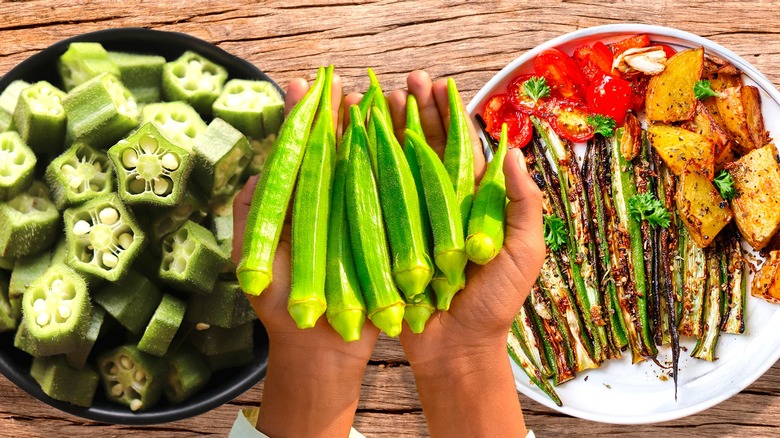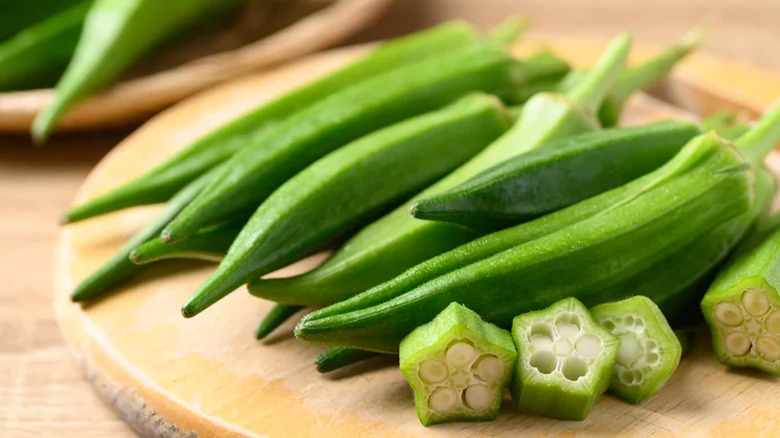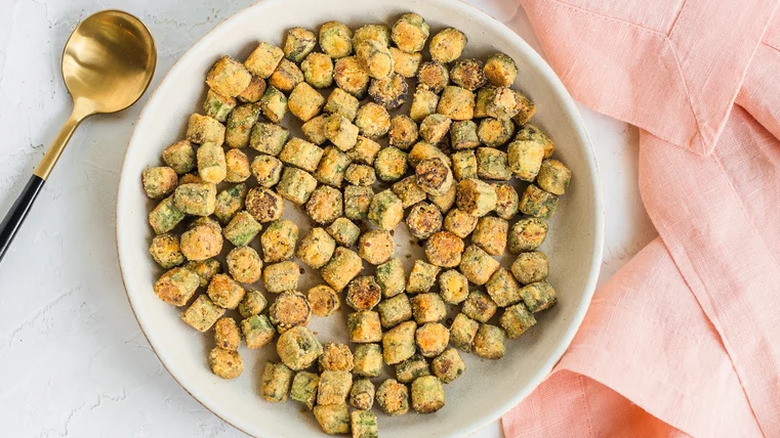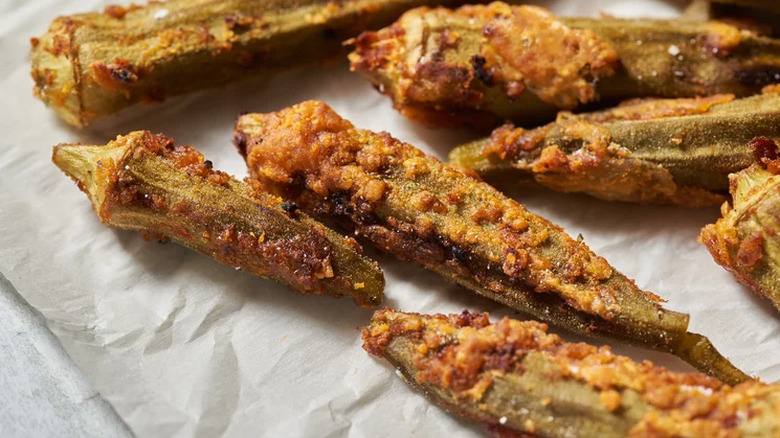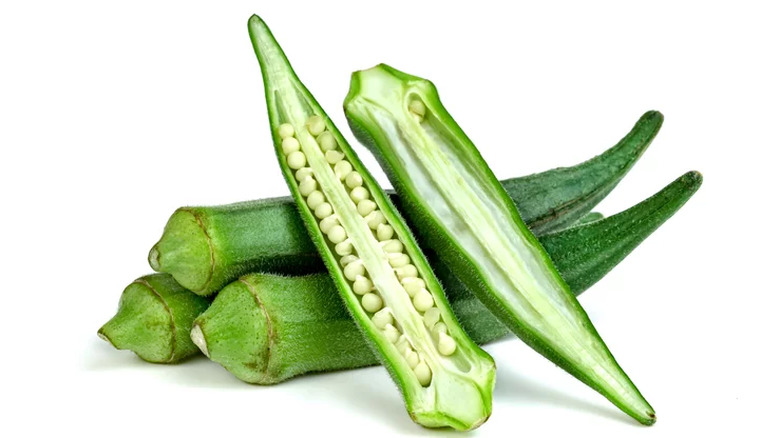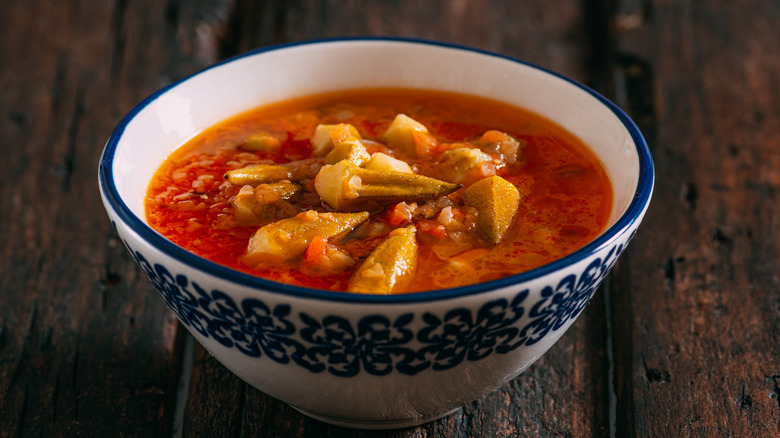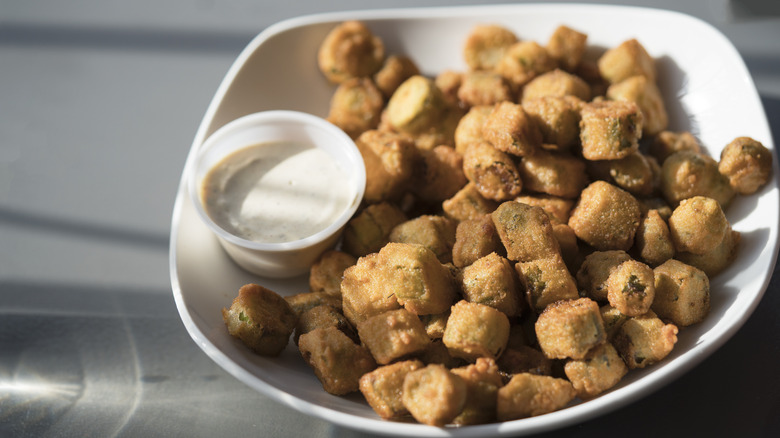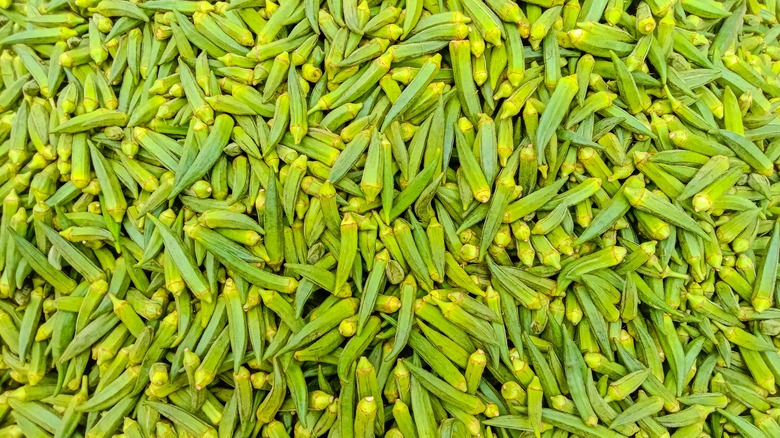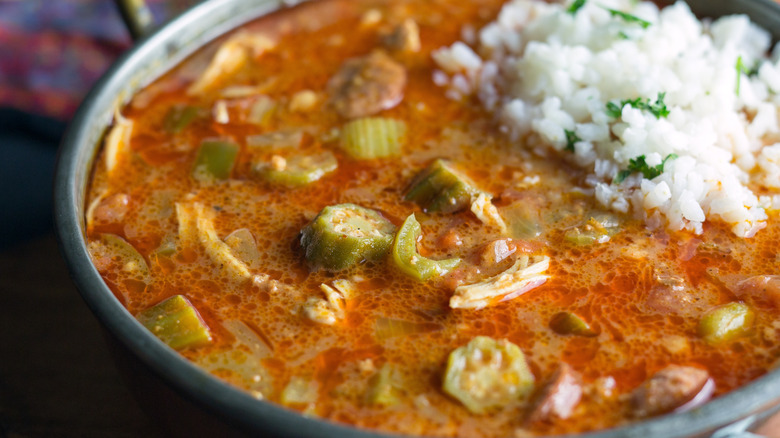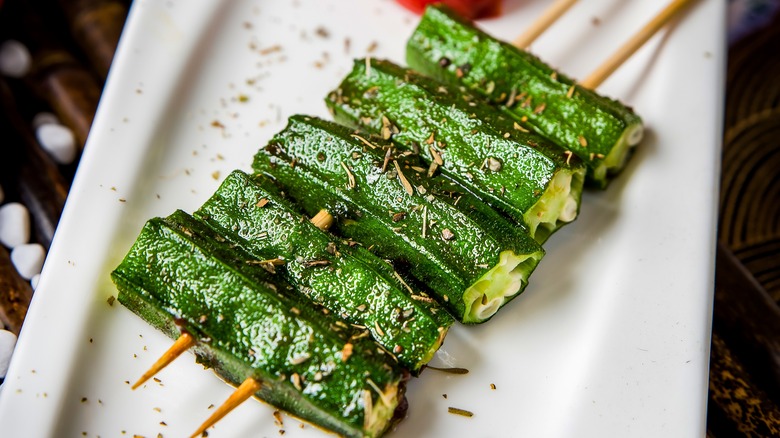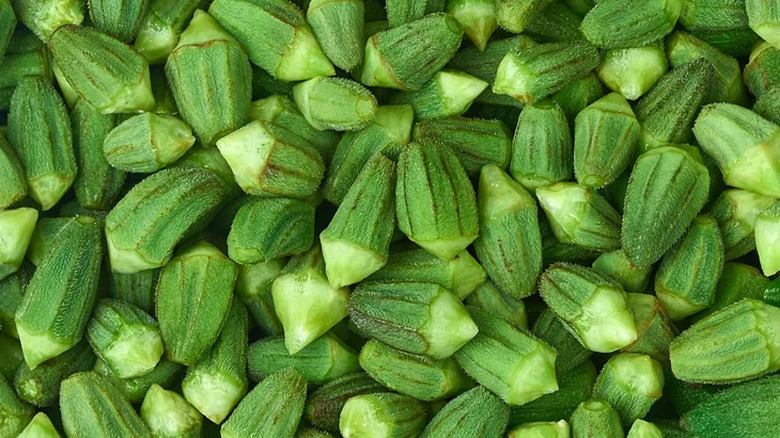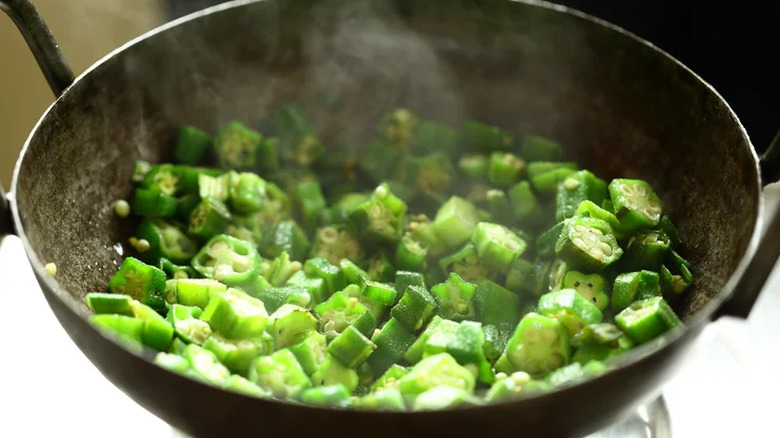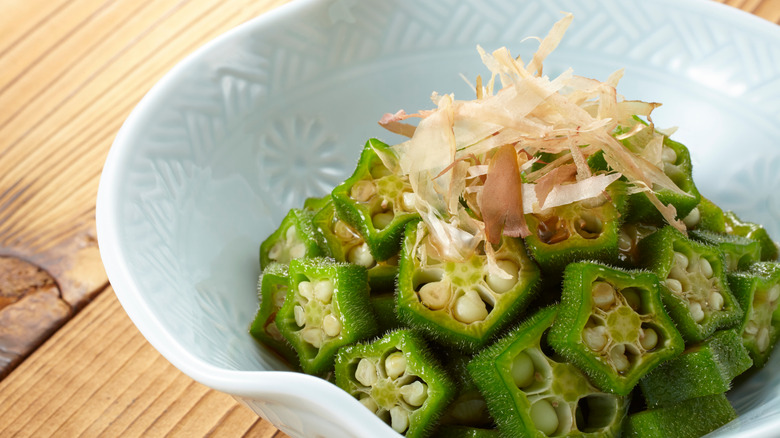12 Tips You Need To Know When Cooking With Okra
Okra is one of the most polarizing vegetables out there — it seems that people either love it or hate it. However, when you look at varied cuisines from around the world, okra is one of the most ubiquitous vegetables. This ingredient is featured in recipes spanning cultures across Africa, Southeast Asia, South America, Mediterranean Europe, the Middle East, the Southern U.S., and beyond. It's prepared in different ways depending on the region, which shows how truly versatile this vegetable is.
For folks who hate okra, it usually comes down to the sliminess of these green pods. They ooze mucilage, a thick, wet, and sticky substance that some people can't get behind. However, many people who don't like okra simply don't know how to prepare it. It can be an intimidating vegetable, but various techniques can help make it less slimy. Others embrace the slime, enjoy the mouthfeel, and take advantage of it to thicken soups and stews.
Okra offers many health-boosting properties, and the mucilage is even shown to have cholesterol-reducing effects. These nutritional benefits have even led to the recent "okra water" trend. There are many reasons to eat okra and even more ways to cook it. With some know-how, you can find a way to enjoy these delicious pods. Here are some tips you need to know when cooking okra.
1. Pick the freshest okra when buying it
Before even getting to the cooking process, you'll need to know how to pick the freshest okra at the store. Piles of okra might be intimidating to you, especially if you don't have experience with this vegetable. It's also important to pick the right okra pods if you want to eat them raw, as older pods can be tough or dried out, making them hard to chew unless they're cooked for a long time. To start, always look for the okra with the brightest green color and avoid the dull, browner-looking pods, or any okra with brown spots.
You also don't want to buy extra-large pods. When it comes to okra, the smaller the better. Really long okra pods tend to be tough and woody in texture, and won't be pleasant to chew. It's best to avoid any that are longer than 4 inches. Lastly, you should always feel the okra in your hand. You want each pod to feel plump and springy, not soft or floppy. A good indication is hearing the seeds snap when you squeeze the pod.
2. Pan-fry okra to reduce slime
One of the main reasons people are put off by okra is because of its slimy texture. Okra's mucilage tends to be released while cooking. However, there are specific ways to cook okra in order to minimize the goo. Cornmeal-breaded pan-fried okra lets you enjoy the vegetable without the slimy texture. Simply slice your okra into small rounds, coat it in the cornmeal, and give the slices a quick sauté until the breading becomes crisp and brown.
You might be wondering how this works. The answer is that the mucilage (which has the same characteristics as the mucilage in aloe vera) becomes thicker as it heats up. So the less time it's spent cooking, the better. That's why a slow-cooked okra will be more slimy than okra cooked with a speedy fry in a hot pan. The added insurance is the cornmeal coating, which will absorb excess mucilage, in addition to it providing a tasty and crispy coating.
3. Make crispy roasted okra in the oven
One of the most common ways that okra is cooked in the South is by breading and deep-frying it. This results in a texture that's crispy on the outside and soft on the inside, which is really pleasant to bite into. Plus, the breading can be seasoned with various spices and some cayenne pepper to give it heat.
To replicate this at home, however, is not easy, and deep-frying requires a lot more work than we're usually willing to put it. That's why we love using a crispy roasted okra recipe that yields the same kind of result in the oven, but with a lot less labor.
Using the oven yields a delicately sweet, roasted okra with crisp browned edges. Oven roasting is a relatively dry cooking method that will help reduce the slime. Season the okra pods whole with olive oil, salt, paprika, garlic powder, and some cayenne pepper, then toss it in some potato starch. If you don't have potato starch, you can use cornstarch instead. Optionally, snipping off the tops of the okra will speed up the cooking process. Spread the pods out on a baking sheet over some parchment paper or foil, and then place it in the oven to bake for about 20 minutes, or until the okra gets crispy and the coating has turned golden-brown.
4. Slice okra properly to minimize sliminess
Most people slice okra into little rounds, cutting across the width of the pod. This results in little seed-filled circular slices that are often pan-fried or thrown into bubbling stews. While there's nothing wrong with this method of cutting, it can release quite a lot of mucilage.
For those who are put off by the slime, this isn't the best technique to cut okra. Fortunately, there's an okra cooking method that could win over its haters by reducing the goo. Instead of rounds, cut your okra lengthways. Slice thin strips of okra from the top of the pod to the bottom, in a kind of julienne cut. This won't guarantee zero slime, but does reduce its pervasiveness.
A tip to help with slicing okra lengthways is to keep the top of the okra intact and slice downwards away from it. This will help hold the okra together and make the pod less messy during the cutting, before you simply slice off the top to free the slices. After cutting your okra lengthwise, it can be fried until crispy and then enjoyed in numerous ways, from topping a salad with the thin strips to snacking on them as is.
5. Cook frozen okra for extra convenience
Okra newbies might not know about using frozen okra instead of fresh, but people who are used to cooking okra will frequently rely on the frozen variety because of its incredible convenience. Using frozen okra has numerous benefits. It requires little to no prep work like washing and cutting. It's also easily available all year round, compared to fresh okra that is in season only during the summer.
Plus, it's also usually more affordable to buy okra frozen. It won't be lacking in any of the nutritional components that okra is celebrated for, because vegetables are often frozen at peak ripeness, and freezing tends to preserve their health benefits.
One of the easiest ways to cook with frozen okra is to simply throw it into various stews or soups. In frozen form, it doesn't crisp up when pan-fried as easily as fresh okra does, so adding it to something saucy that it will stew in is a better choice. You can make a Middle Eastern-inspired stew with beef, okra, and tomatoes, or you could use it in gumbo. Alternatively, frozen okra works well when oven-roasted, so you could drizzle some olive oil and seasonings on your frozen okra and let it bake in the oven until it's nicely browned.
6. Deep-fry okra to win over the haters
In the U.S., when one thinks of okra, there's an immediate connection to the South. Okra has a deep-rooted history in Southern cuisine, with origins stretching back to Africa and the enslaved people who brought this vegetable with them. Since then, numerous okra recipes have become an integral part of Southern cooking, and the veggie features prominently in beloved dishes like gumbo.
Among these dishes is deep-fried okra, arguably one of the most popular ways to eat it. Of course, deep-frying makes everything tastier, but with okra, it's a genius technique to reduce sliminess and give this vegetable — which is ordinarily soft after cooking — a crispy texture.
For deep-frying, it's best to use fresh okra — if that's not available, you can use frozen okra, but you'll need to thaw it first. Then, slice the okra into little rounds and toss it into seasoned flour or cornmeal (or a mix of the two), before deep-frying the okra until it's golden-brown and crispy. Serve with some aioli for extra decadence.
7. Soak okra in vinegar before cooking
If you simply can't deal with okra slime, there are ways to get around it. Sure, there are certain cooking and cutting techniques that will help you get rid of the goo. But if you want to reduce the slime before you even begin cooking, there's a more fuss-free technique.
A vinegar soak is all you need to fix slimy okra. Interestingly, okra's mucilage dissolves when acid is applied to it. Vinegar or other acidic foods like lemon juice or tomatoes work to break down the slime. That's a good reason why many okra recipes are paired with tomatoes, or cooked in a tomato-based sauce. It also partly explains why pickling okra is popular.
To give your okra a vinegar soak, submerge fresh okra pods in vinegar for about 30 minutes. Use 125 milliliters of vinegar for every 500 grams of okra, making sure the pods are thoroughly exposed to the vinegar. Then, rinse the okra and dry it before proceeding with cooking.
8. Use okra to thicken soup
Many recipes and tips for cooking okra focus on getting rid of the slime. This infamous translucent substance gets a lot of hate, but it's actually very useful. If you learn how to use the slime, it can become a nifty trick to use in the right circumstances. For example, okra can be your secret weapon for thickening soups.
There are various ways that cooks try to make a thick and luscious soup, but with okra, you don't have to try. The mucilage works to create more body in your soup, giving it a thicker, more comforting mouthfeel. This isn't a new trick by any means, and it's often the secret behind the thick and velvety consistency of gumbo.
The mucilage in the okra tends to become more viscous when it comes in contact with heat and water. That's what makes it perfect for soup, which features both of those. As your soup simmers, the mucilage will be released into it, making the best use of this healthy substance. Meanwhile, you're increasing your vegetable intake and adding some earthy flavor with this deliciously soft ingredient. It's a win-win situation.
9. Grill okra at your next barbecue
Perhaps one of the best things about warmer weather is being able to get the grill out for a barbecue. Almost anything tastes better when it's cooked over an open flame, and okra is no different. Grilled okra is perhaps one of the easiest ways to convert even the most staunch haters of this veggie, and it's really easy to cook it this way, since the pods don't need much preparation.
All you need to do is to get the pan or grill to a solid level of medium heat. Brush some whole okra pods with olive oil and add them to the grill. You can skewer them on some wooden kebab sticks for easier handling. Get the pods nicely browned, turning them over so that they get grilled on both sides. The slight char on the okra is great for bringing out the sweetness of each pod.
Before serving, sprinkle some salt and squeeze some lemon juice on them. The lemon juice not only adds an acidic brightness to the okra, but can also help reduce any residual sliminess. Cooked like this, okra can rival grilled asparagus or broccoli, and become a contender for the best-grilled veggie at your barbecue. Serve the grilled okra plain, or provide it with a creamy dip to make for a tempting combo.
10. Opt for baby okra whenever possible
A good rule of thumb to follow when shopping for this versatile veggie is that small okra pieces are always best. If there's a large pile of okra at the grocery store or the market, always try to select the pods that are smaller in size, to avoid any tough or woody okra. You want your okra to be about 2 or 3 inches long, or even smaller if possible.
From our experience, the absolute best okra to cook is baby okra. These are the most tender and easy to cook, with no sign of woodiness or fibrous texture. They're also small enough that you don't have to chop them up, and you can simply cook them whole.
However, finding fresh baby okra isn't always easy. Since young okra is a preferred ingredient in Middle Eastern recipes like Egyptian bamia, you're more likely to find frozen baby okra in a Middle Eastern grocery store. In the frozen section look for "okra zero" and enjoy cooking these tiny pods in all the ways that you would use okra in varied recipes.
11. Embrace the slime
Everyone who cooks okra has some advice about how to cope with the slime. However, okra is such a unique vegetable, and the mucilage is a big part of what makes it one of a kind. Some might say that the biggest mistake you're making with okra is fighting the slime.
Many cultures around the world enjoy foods with different textures, and gooey isn't always seen as a bad thing. Okra is often loved and celebrated specifically because of its slippery texture, and the vegetable is cooked in ways to enhance this characteristic. As more people are discovering the health benefits of okra mucilage, it's become a wellness trend to soak okra in water to draw out the slimy goodness, and then drink this straight up in a glass.
If that's a wellness-boosting bridge too far for you, start with cooking okra in ways where you use the slime to your advantage instead. Sure, okra can be added to soups to thicken them up, and we've seen that it's an essential addition to gumbo, but you don't have to stop there. Add okra to any liquid-based dish like stew, curry, or even risotto. The pods will add flavor and thicken the consistency of whatever you're cooking, adding more depth. Plus, then you don't have to worry about all these time-consuming techniques to help reduce the sliminess. Simply chop the pods up and throw them into your pot.
12. Enjoy okra raw in a salad
Many people don't realize that you don't have to cook okra at all. You can eat it raw, and this is a delicious way to have okra.
Salada de quiabo is a widely beloved dish of Brazil's northeastern regions, which is essentially an okra salad with vinaigrette that is commonly served as a side dish. Many recipes call for boiling the okra before making this specialty, but raw baby okra is tender enough to be added to salada de quiabo and enjoyed as is — and the mucilage even blends in with the dressing.
You can make any kind of okra salad you like. If young okra is not available, briefly blanch your pods and slice them up before mixing them with whatever vegetables you're using. You can keep it plain and just use okra like the Brazilian salad, or mix in some diced tomatoes, peppers, onion, corn, or any greens you fancy. Make sure to use an acid-based dressing like a vinaigrette, or simply squeeze some lemon juice on it to help the mucilage dissolve slightly. Voilà — you have your next summer salad or side dish for the barbecue.
